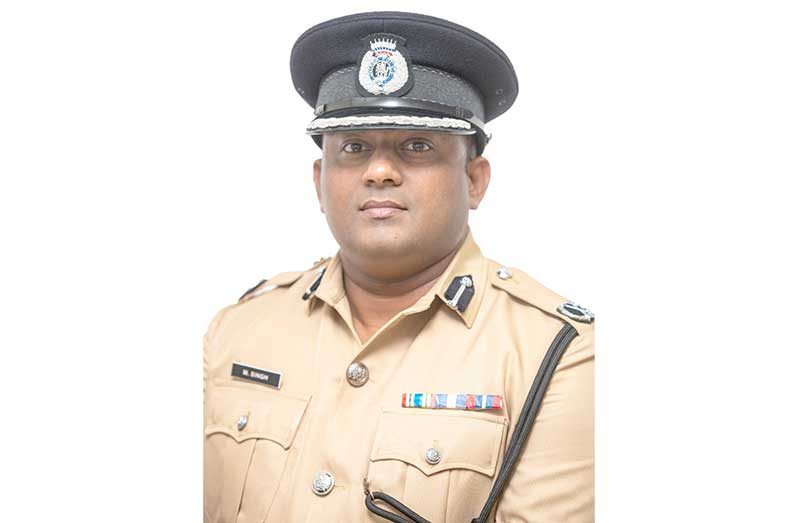– Traffic Chief details new approaches to road safety
– crash hotspots mapped as police, engineers tackle rural road hazards
WITH road deaths surpassing the 170 in 2024, Guyana’s Traffic Department is intensifying its battle against reckless driving, seeking to shift deep-rooted cultural habits and restore public confidence in law enforcement.
According to Assistant Commissioner and Traffic Chief, Mahendra Singh, a combination of education, enforcement, technology, and transparency is driving the country’s most aggressive road safety effort in years.
More than 60 percent of fatal accidents in Guyana are linked to speeding and dangerous driving, Singh confirmed. These deadly behaviours, he noted, are rooted in a weak road culture, peer pressure—particularly among younger drivers—and a longstanding tolerance for rule-breaking, including running red lights, neglecting seatbelts, and driving under the influence.
“Too many drivers still treat traffic laws as optional,” Singh said. “We’re working to change that mindset from the ground up.”
To that end, the Traffic Department has rolled out a series of nationwide public awareness campaigns. These include road safety education in schools, workplaces, hospitals, markets, and faith centres, as well as televised and radio public service announcements and scrolling messages on ⁶digital billboards. Defensive driving seminars are also being conducted for both private and government-employed drivers.
Singh stressed that these efforts are complemented by a stronger police presence in high-risk areas and accident “blackspots,” with enforcement guided by crash data that identifies trends by region, vehicle type, and repeat offenders.
SMART TECHNOLOGY MAKING ROADS SAFER
The deployment of surveillance technology and automated ticketing has also begun to yield results.
Thousands of violations—including speeding, red-light breaches, and other infractions—are now automatically captured by cameras under the Smart Road and Intelligent Surveillance (SRIS) system and Smart City platform. The use of these systems not only increases accountability but also minimises the need for officers to stop vehicles on the road, significantly reducing opportunities for bribery.
“Most enforcement is now based on digital evidence, not officer discretion,” Singh emphasised. “Everyone is held to the same standard—same rules, same system, same outcome.”
Public support for speed cameras and e-ticketing has grown steadily, Singh added, noting that future expansion will target more roads, new categories of offences (like driving while using a mobile phone), and wider geographic coverage beyond Georgetown.
In response to growing public concern over heavy-duty trucks, minibuses, and electric bikes, the Traffic Department has implemented stricter regulations across the board.
Heavy trucks and lorries—often flagged for overloading, unsecured cargo, and nighttime speeding—are now under tighter scrutiny, especially on major supply chain routes involving sand, stone, and logs. Police are coordinating with the Ministry of Public Works to enforce axle load limits, conduct roadworthiness checks, and maintain weigh stations. New police outposts have been established along key corridors for 24/7 monitoring.
Minibuses, known for erratic driving, speeding, and blasting loud music, are subject to greater oversight through stricter control of fitness certificates, service licences, and joint patrols with traffic stations. Singh said these sustained measures led to a reduction in serious crashes involving minibuses in 2024.
Electric bikes, increasingly common in urban zones and private compounds, are now being regulated through a phased licensing regime aimed at promoting accountability and safety. Public education campaigns are also underway to support this initiative.
Poor road conditions—especially in remote areas—remain a major contributing factor to traffic accidents, Singh acknowledged. He said police are now working more closely with the Ministry of Public Works to share crash data, conduct joint safety audits, and initiate targeted improvements.
“We’ve seen real impact from things like new signage, reflective road paint, speed bumps, and better lighting,” Singh noted.
In areas where resurfacing is delayed, police are deploying temporary warning signs and increasing community outreach to prevent accidents. While resource limitations continue to affect the pace of road upgrades, Singh said coordination between agencies has significantly improved.
RESTORING PUBLIC TRUST IN TRAFFIC ENFORCEMENT
One of the most persistent complaints from the public has been the perceived inequality in how traffic laws are enforced—especially in Regions Four, Six, and 10.
To combat this perception, Singh pointed to a series of integrity-driven reforms: SRIS cameras and e-ticketing systems eliminate human bias by relying entirely on digital evidence; Body-worn
cameras are now standard for all operational traffic officers; and the department has introduced internal monitoring systems to track enforcement patterns and identify irregularities.
“Officers are being held accountable,” Singh said. “We’ve already launched investigations into several bribery complaints, and disciplinary action is being taken where appropriate.”
He underscored a clear message to both officers and the public: “No exceptions — the law applies to everyone equally.”
While Singh acknowledged that Guyana’s traffic culture will not change overnight, he remains confident that the current combination of education, enforcement, technology, and public accountability will yield lasting results.
“Our goal isn’t just to catch violators — it’s to build a safer, more respectful road culture,” he said.



.jpg)








